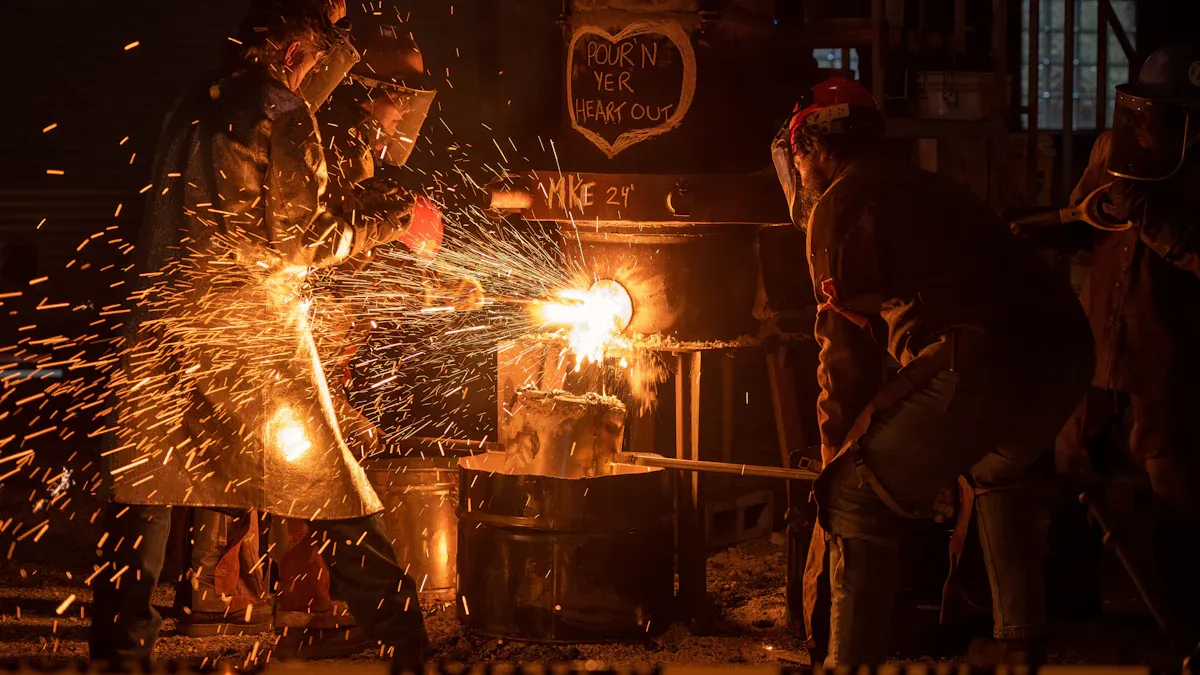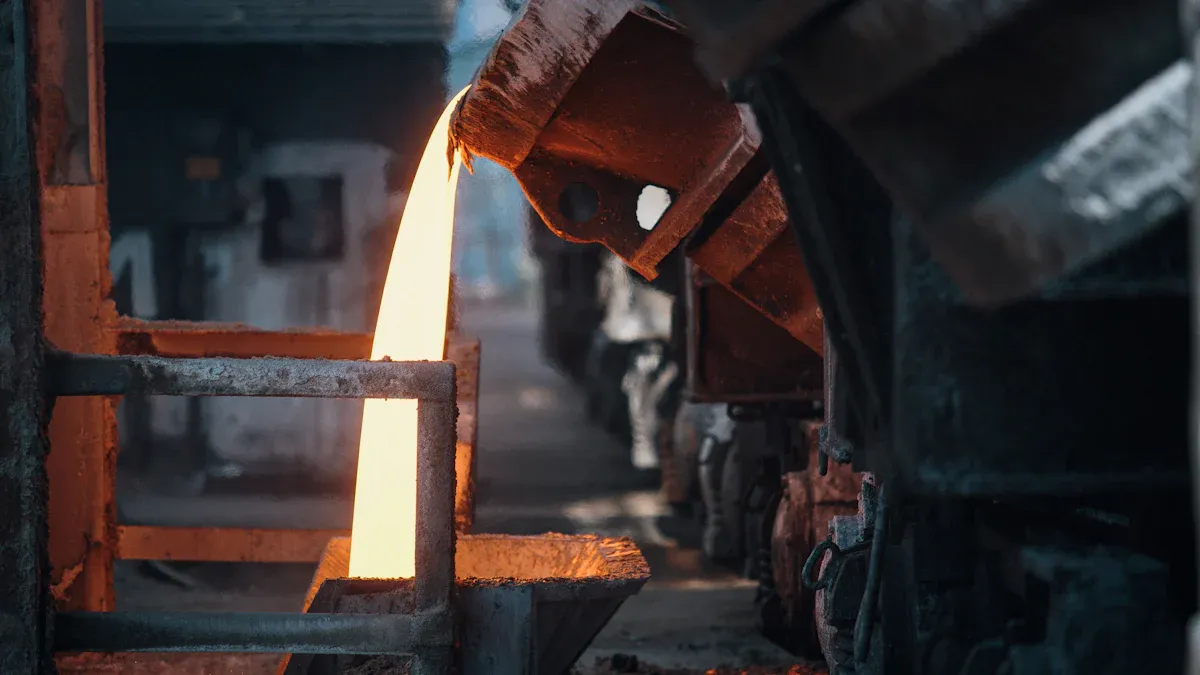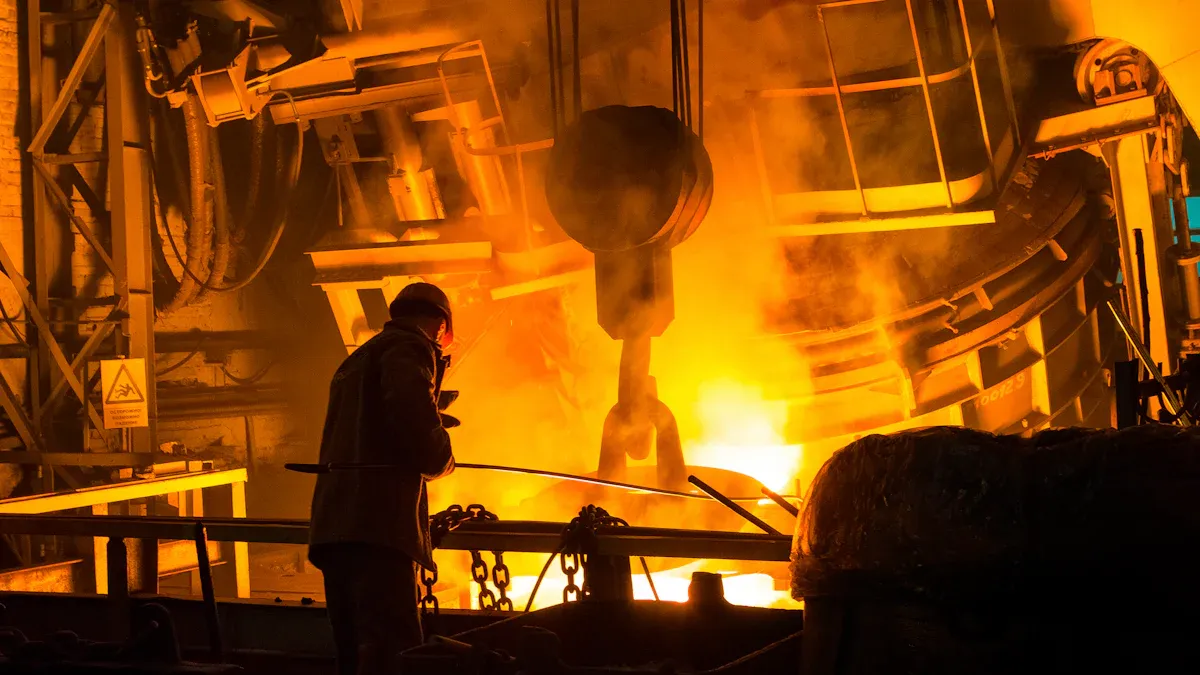
Silicon Bronze Precision Castings play a vital role in modern manufacturing. These castings, known for their strength and corrosion resistance, have become essential in industries like marine, aerospace, and architecture. In 2025, their applications are expanding rapidly. For instance:
- Global shipbuilding output rose by 6% in 2023, increasing demand in marine projects.
- The U.S. infrastructure program, with $1.2 trillion allocated, prioritizes corrosion-resistant materials such as silicon bronze.
- Electric vehicle production and offshore wind energy projects are also driving innovation, showcasing the versatility of Silicon Bronze Precision investment Castings.
Advancements in casting technology and material science further enhance their appeal, making them indispensable across industries. Whether it’s creating durable marine components or intricate architectural designs, these castings deliver exceptional performance. Their compatibility with processes like welding adds to their value, as seen in Silicon Bronze Precision Castings for Welding.
Key Takeaways
- Silicon Bronze Castings are important in marine, aerospace, and building industries. They are strong and resist rust.
- The casting process improves silicon bronze’s natural features. It helps make tough and detailed parts.
- New uses in green energy and electric cars show how useful silicon bronze is. Its demand is rising in today’s factories.
Overview of Silicon Bronze Precision Castings
Silicon Bronze as a Material
Silicon bronze is a copper-based alloy that combines copper with silicon and other elements like zinc or manganese. This unique composition gives it a balance of strength, corrosion resistance, and workability. Manufacturers often choose silicon bronze for its versatility and ability to meet the demands of various industries.
The material is particularly popular in environments where durability is critical. For example, marine and industrial applications benefit from its ability to withstand harsh conditions. Recent studies highlight its growing use in advanced manufacturing processes, which improve both precision and efficiency. High silicon bronze is favored for its strength and performance at high temperatures, while low leaded silicon bronze offers a cost-effective alternative for less demanding applications.
Properties of Silicon Bronze
Silicon bronze stands out due to its impressive properties. Its high tensile strength allows it to endure extreme conditions, making it ideal for marine environments where exposure to saltwater is constant. Unlike brass alloys, silicon bronze resists corrosion effectively, preventing rust and erosion over time.
Another key property is its ductility. This characteristic makes the material easy to shape during manufacturing processes like casting. Its versatility ensures that it can be used for intricate designs or heavy-duty components. Additionally, silicon bronze has an appealing aesthetic, often used in architectural and decorative applications for its warm, golden hue.
Key properties of silicon bronze include:
- High tensile strength for durability in harsh conditions.
- Superior corrosion resistance, especially in saltwater environments.
- Ductility, allowing for easy shaping and intricate designs.
- Aesthetic appeal, making it suitable for decorative purposes.
Precision Casting Process Explained
Precision casting, also known as investment casting, is a manufacturing process that creates detailed and accurate components. When applied to silicon bronze, this process enhances the material’s natural properties, resulting in high-quality castings.
The process begins with creating a wax model of the desired component. This model is coated with a ceramic shell, which hardens to form a mold. Once the wax is melted away, molten silicon bronze is poured into the mold. After cooling, the ceramic shell is removed, revealing the finished casting.
This method is highly efficient and produces minimal waste. It also allows for the creation of complex shapes and fine details that other methods might struggle to achieve. Industries like aerospace and architecture rely on precision casting to produce components that meet exact specifications.
Tip: Precision casting is ideal for projects requiring both strength and intricate designs, making it a perfect match for silicon bronze.
Applications of Silicon Bronze Precision Castings in 2025

Marine Industry Applications
The marine industry relies heavily on materials that can withstand harsh environments. Silicon Bronze Precision Castings have become a go-to choice for marine components due to their exceptional corrosion resistance and durability. These castings are commonly used for boat fittings, propellers, and fasteners, where exposure to saltwater is constant.
The global bronze market is projected to grow at a compound annual growth rate (CAGR) of 3.00% from 2025 to 2033. This growth reflects the increasing demand for bronze in marine applications. As shipbuilding activities expand worldwide, manufacturers are turning to silicon bronze for its ability to endure extreme conditions while maintaining structural integrity.
Did you know? Silicon bronze is not only durable but also easy to work with, making it ideal for custom marine hardware designs.
Aerospace Industry Applications
In aerospace, precision and reliability are non-negotiable. Silicon Bronze Precision Castings meet these demands by offering high tensile strength and resistance to wear. These properties make them suitable for components like landing gear parts, engine components, and structural supports.
The aerospace sector also benefits from the material’s lightweight nature. By reducing the overall weight of aircraft, silicon bronze contributes to improved fuel efficiency. Additionally, its ability to perform well under high temperatures ensures that critical components remain functional during extreme conditions.
As the aerospace industry continues to innovate, the use of advanced materials like silicon bronze is expected to grow. Its compatibility with precision casting processes allows manufacturers to produce intricate designs that meet stringent safety and performance standards.
Architectural and Decorative Applications
Silicon bronze is a favorite in architecture and design, thanks to its unique combination of functionality and aesthetics. Its warm, golden hue and resistance to tarnishing make it a popular choice for decorative elements like railings, sculptures, and door hardware.
In addition to its visual appeal, silicon bronze offers remarkable durability. It resists corrosion even in outdoor settings, making it ideal for architectural projects exposed to the elements. For example, it is often used in bridges, monuments, and building facades where both strength and beauty are essential.
This material’s versatility allows architects and designers to create intricate patterns and shapes without compromising on durability. Whether it’s a modern skyscraper or a historic restoration project, silicon bronze adds a touch of elegance while standing the test of time.
Emerging Applications in Modern Industries
Beyond traditional uses, Silicon Bronze Precision Castings are finding their way into emerging industries. Renewable energy is one such area where this material is making an impact. Components for offshore wind turbines and solar panel mounts benefit from silicon bronze’s corrosion resistance and strength.
The electric vehicle (EV) industry is another growing market. Silicon bronze is used in battery connectors and other electrical components due to its excellent conductivity and durability. As EV production ramps up, the demand for high-performance materials like silicon bronze is expected to rise.
Additionally, advancements in 3D printing and additive manufacturing are opening new doors for silicon bronze. These technologies enable the creation of complex, custom components that were previously difficult to produce. This innovation is paving the way for silicon bronze to play a role in industries like robotics, medical devices, and even space exploration.
Tip: Keep an eye on emerging technologies. They often drive the development of new applications for materials like silicon bronze.
Benefits of Silicon Bronze Precision Castings
Durability and Strength
Silicon bronze is renowned for its exceptional durability and strength, making it a reliable choice for demanding applications. Its Brinell hardness number, ranging from 60 to 100, highlights its resistance to wear and indentation. This property ensures that components made from silicon bronze can withstand heavy use without degrading. Additionally, the material boasts a tensile strength of 400 to 600 MPa, allowing it to endure significant stress before failure. These qualities make it ideal for industries like aerospace and marine, where reliability is critical.
Corrosion Resistance
One of the standout features of silicon bronze is its superior corrosion resistance. When exposed to air, it forms a protective oxide layer that prevents further corrosion. This self-healing property ensures long-lasting performance, even in aggressive environments. For example, silicon bronze performs exceptionally well in coastal areas with high humidity and salt content. It resists moisture, saltwater, and industrial pollutants, making it a preferred material for outdoor installations like grounding rods and marine hardware.
Cost-Effectiveness
Silicon bronze offers a cost-effective solution for industries requiring durable and corrosion-resistant materials. Its longevity reduces the need for frequent replacements, saving both time and money. Additionally, its versatility allows manufacturers to use it across various applications, maximizing its value.
Aesthetic and Artistic Appeal
Beyond its functional benefits, silicon bronze is prized for its aesthetic qualities. Its warm, golden hue adds a touch of elegance to architectural and decorative projects. It resists tarnishing, ensuring that sculptures, railings, and other decorative elements maintain their beauty over time. This combination of durability and visual appeal makes it a favorite among architects and designers.
Innovations and Trends in Silicon Bronze Precision Castings

Advancements in Casting Technology
Casting technology has come a long way, and it’s making a big difference in how Silicon Bronze Precision Castings are produced. Modern techniques like 3D printing and computer-aided design (CAD) allow manufacturers to create highly detailed molds with incredible accuracy. These advancements reduce material waste and speed up production.
One exciting development is the use of automated systems in the casting process. Robots now handle repetitive tasks, ensuring consistent quality and minimizing human error. This level of precision is especially important for industries like aerospace, where even the smallest flaw can have serious consequences.
Note: Automation doesn’t just improve quality—it also lowers production costs, making these castings more accessible to a wider range of industries.
Sustainable Manufacturing Practices
Sustainability is becoming a top priority in manufacturing, and the production of Silicon Bronze Precision Castings is no exception. Many foundries are adopting eco-friendly practices, such as recycling scrap metal and using energy-efficient furnaces. These steps help reduce the environmental impact of casting operations.
Another trend is the shift toward biodegradable or reusable mold materials. This change not only cuts down on waste but also aligns with global efforts to promote greener manufacturing. Companies that embrace these practices often find they save money in the long run while appealing to environmentally conscious customers.
Material Enhancements and New Alloys
Material science is constantly evolving, and silicon bronze is benefiting from these advancements. Researchers are experimenting with new alloy compositions to enhance specific properties like strength, corrosion resistance, and thermal stability. For example, adding trace amounts of nickel or aluminum can improve the material’s performance in extreme conditions.
These innovations open doors for silicon bronze to be used in even more demanding applications. Whether it’s for high-pressure marine environments or cutting-edge aerospace components, enhanced alloys ensure the material stays ahead of the curve.
Expanding Applications in Emerging Fields
The versatility of Silicon Bronze Precision Castings is driving their adoption in emerging industries. Renewable energy is a prime example. Wind turbines and solar panel mounts require materials that can withstand harsh outdoor conditions, making silicon bronze an ideal choice.
In the medical field, the material is gaining attention for its biocompatibility and durability. It’s being used in surgical instruments and implants, where precision and reliability are critical. Even the robotics industry is exploring silicon bronze for its ability to handle wear and tear in moving parts.
Tip: As technology advances, expect to see silicon bronze playing a bigger role in industries you might not have considered before.
Silicon bronze precision castings remain a cornerstone of modern manufacturing in 2025. Their unmatched durability, corrosion resistance, and versatility make them indispensable across industries.
Key takeaway: These castings not only meet today’s demands but also pave the way for innovation in design and sustainable manufacturing. Their future looks bright.
FAQ
What makes silicon bronze better than other alloys for casting?
Silicon bronze offers superior corrosion resistance, high tensile strength, and excellent ductility. These qualities make it ideal for demanding applications like marine and aerospace industries.
Can silicon bronze precision castings be used in outdoor environments?
Yes! Silicon bronze resists tarnishing and corrosion, even in harsh outdoor conditions. It’s perfect for architectural projects like sculptures, railings, and building facades.
Are silicon bronze precision castings eco-friendly?
Many manufacturers use sustainable practices, like recycling scrap metal and energy-efficient furnaces. These efforts reduce waste and make silicon bronze a greener choice.
